Qantas Airlines Strategic Management Report: PESTLE, Porter's, SWOT
VerifiedAdded on 2022/08/20
|12
|2957
|310
Report
AI Summary
This report provides a comprehensive strategic analysis of Qantas Airlines, evaluating its external environment and strategic management. It begins with an executive summary outlining the report's objectives, which include assessing the airline's competitive landscape using Porter's Five Forces, analyzing the macro-environment through PESTLE analysis, and examining Qantas's business and corporate-level strategies. The report delves into Qantas's CSR initiatives, managerial ethics, and resource-based view. It includes detailed analyses of the airline's strengths, weaknesses, opportunities, and threats (SWOT), as well as an examination of its leadership. The report concludes with recommendations aimed at achieving sustainable competitive advantages and ensuring the airline's growth and long-term success within the dynamic aviation industry. The report also considers the impact of various factors such as political instability, economic fluctuations, social trends, technological advancements, legal regulations, and environmental concerns on Qantas's operations and strategic decisions. The analysis also includes the bargaining power of buyers and suppliers, the threat of new entrants and substitutes, and the competitive rivalry within the airline industry, highlighting the challenges and opportunities Qantas faces in maintaining its market position.
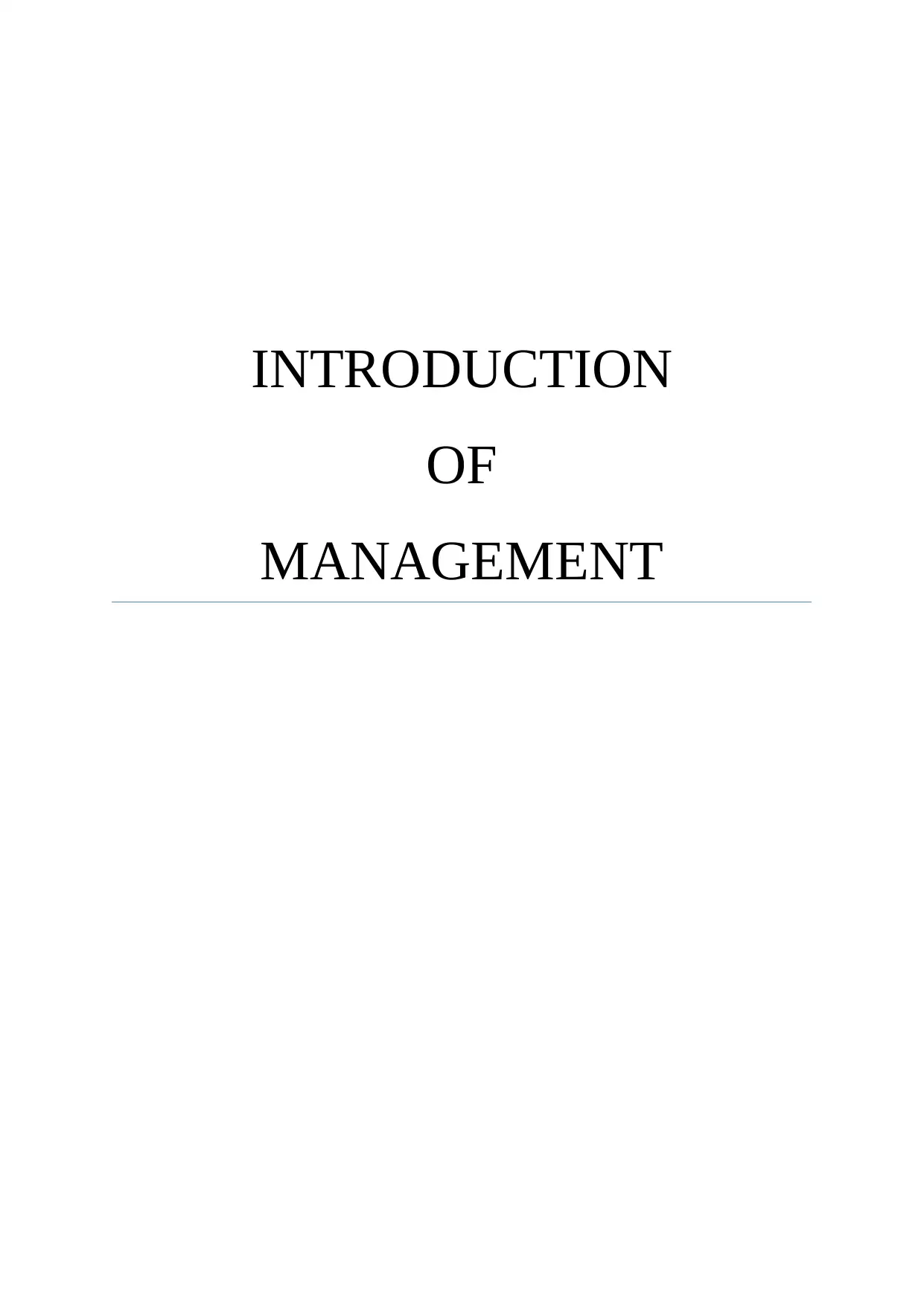
INTRODUCTION
OF
MANAGEMENT
OF
MANAGEMENT
Paraphrase This Document
Need a fresh take? Get an instant paraphrase of this document with our AI Paraphraser
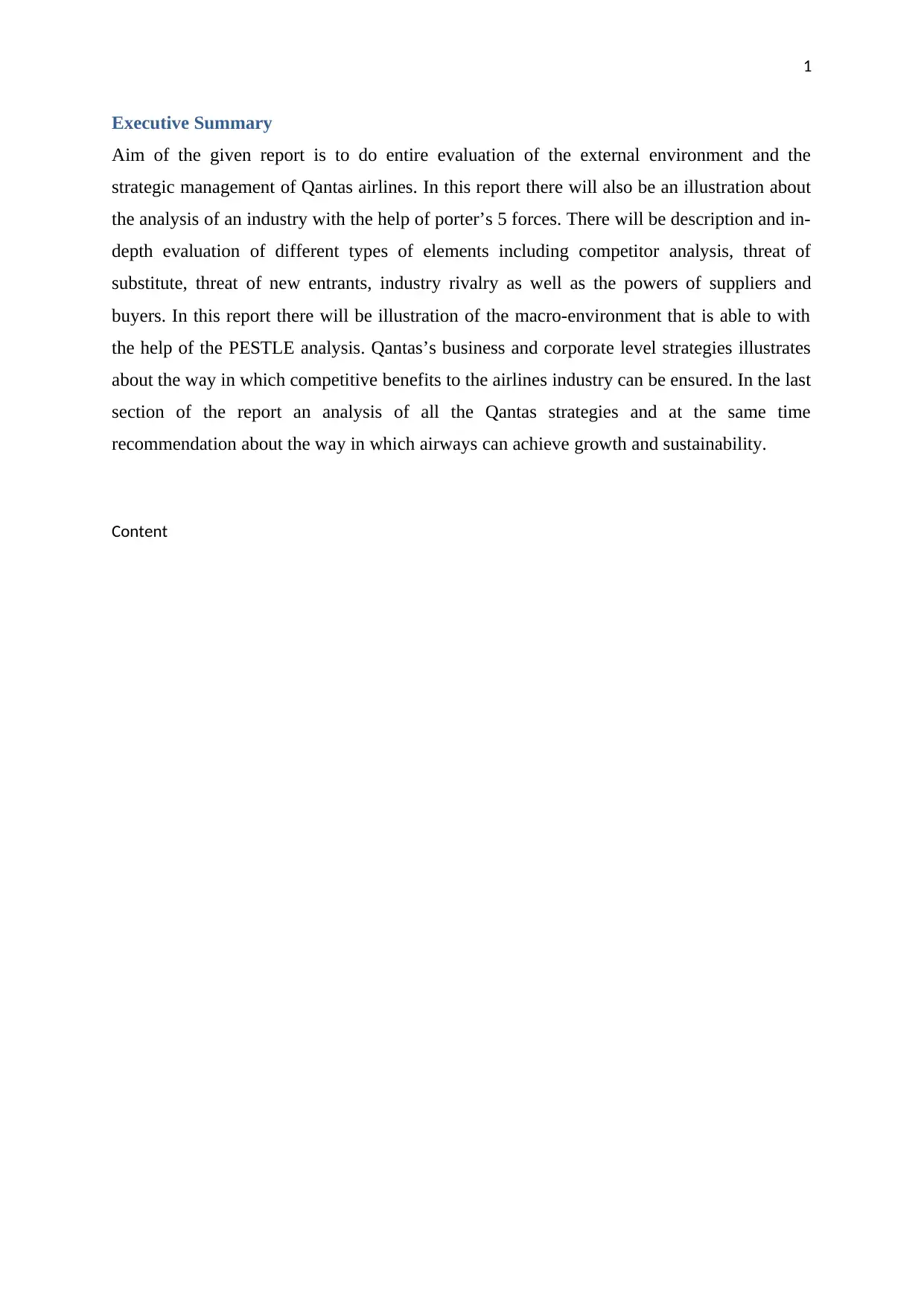
1
Executive Summary
Aim of the given report is to do entire evaluation of the external environment and the
strategic management of Qantas airlines. In this report there will also be an illustration about
the analysis of an industry with the help of porter’s 5 forces. There will be description and in-
depth evaluation of different types of elements including competitor analysis, threat of
substitute, threat of new entrants, industry rivalry as well as the powers of suppliers and
buyers. In this report there will be illustration of the macro-environment that is able to with
the help of the PESTLE analysis. Qantas’s business and corporate level strategies illustrates
about the way in which competitive benefits to the airlines industry can be ensured. In the last
section of the report an analysis of all the Qantas strategies and at the same time
recommendation about the way in which airways can achieve growth and sustainability.
Content
Executive Summary
Aim of the given report is to do entire evaluation of the external environment and the
strategic management of Qantas airlines. In this report there will also be an illustration about
the analysis of an industry with the help of porter’s 5 forces. There will be description and in-
depth evaluation of different types of elements including competitor analysis, threat of
substitute, threat of new entrants, industry rivalry as well as the powers of suppliers and
buyers. In this report there will be illustration of the macro-environment that is able to with
the help of the PESTLE analysis. Qantas’s business and corporate level strategies illustrates
about the way in which competitive benefits to the airlines industry can be ensured. In the last
section of the report an analysis of all the Qantas strategies and at the same time
recommendation about the way in which airways can achieve growth and sustainability.
Content
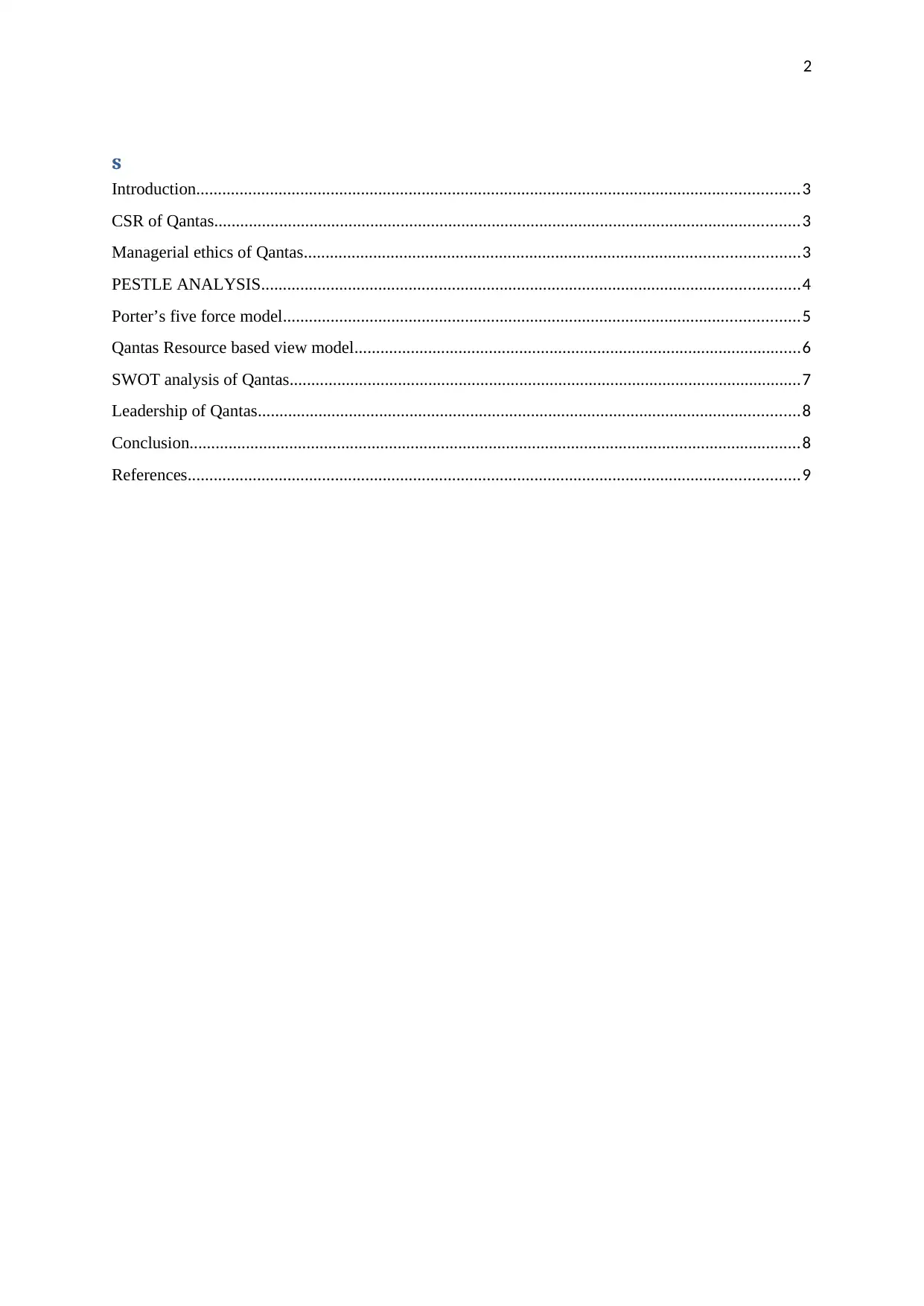
2
s
Introduction...........................................................................................................................................3
CSR of Qantas.......................................................................................................................................3
Managerial ethics of Qantas..................................................................................................................3
PESTLE ANALYSIS............................................................................................................................4
Porter’s five force model.......................................................................................................................5
Qantas Resource based view model.......................................................................................................6
SWOT analysis of Qantas......................................................................................................................7
Leadership of Qantas.............................................................................................................................8
Conclusion.............................................................................................................................................8
References.............................................................................................................................................9
s
Introduction...........................................................................................................................................3
CSR of Qantas.......................................................................................................................................3
Managerial ethics of Qantas..................................................................................................................3
PESTLE ANALYSIS............................................................................................................................4
Porter’s five force model.......................................................................................................................5
Qantas Resource based view model.......................................................................................................6
SWOT analysis of Qantas......................................................................................................................7
Leadership of Qantas.............................................................................................................................8
Conclusion.............................................................................................................................................8
References.............................................................................................................................................9
⊘ This is a preview!⊘
Do you want full access?
Subscribe today to unlock all pages.

Trusted by 1+ million students worldwide
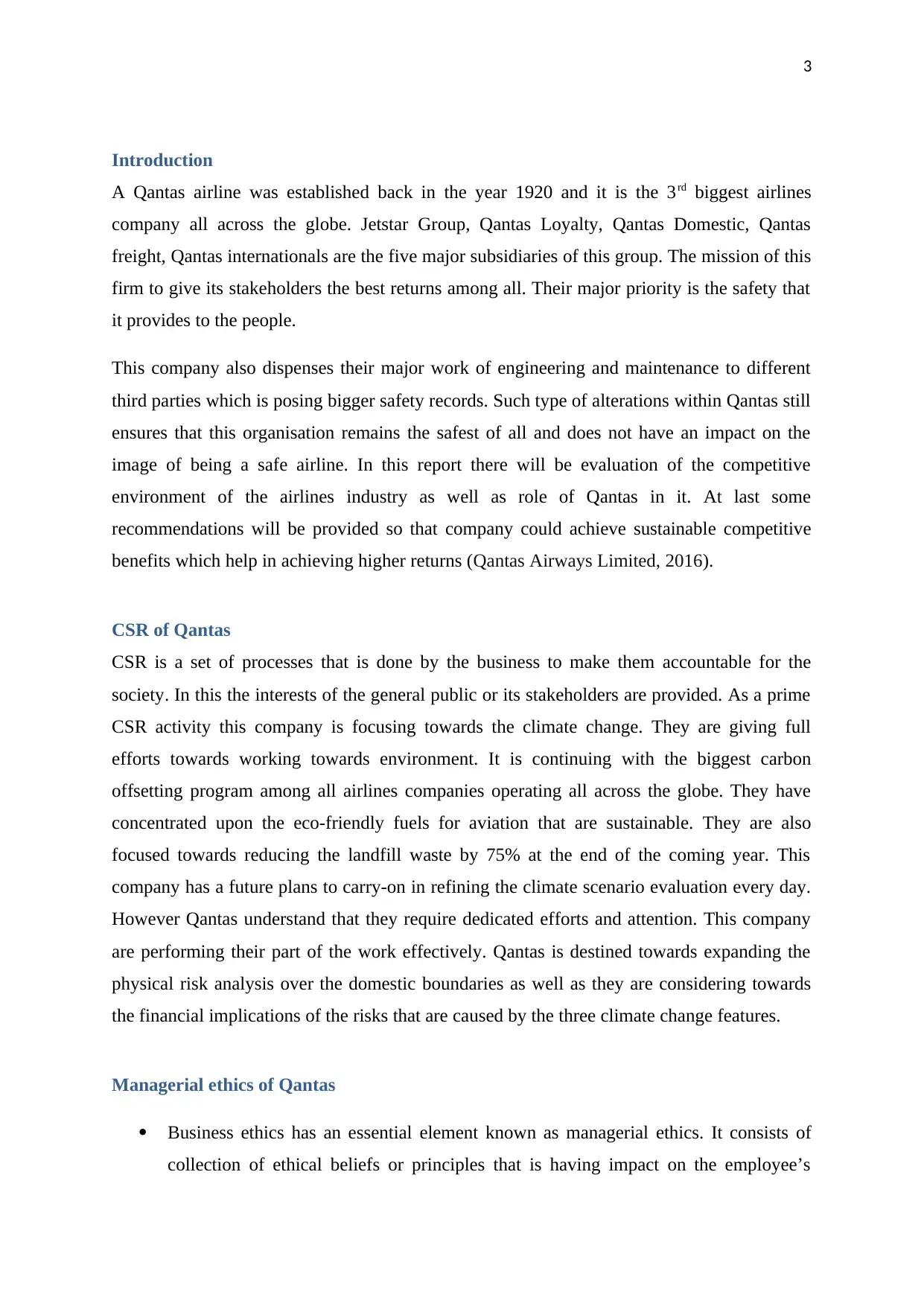
3
Introduction
A Qantas airline was established back in the year 1920 and it is the 3rd biggest airlines
company all across the globe. Jetstar Group, Qantas Loyalty, Qantas Domestic, Qantas
freight, Qantas internationals are the five major subsidiaries of this group. The mission of this
firm to give its stakeholders the best returns among all. Their major priority is the safety that
it provides to the people.
This company also dispenses their major work of engineering and maintenance to different
third parties which is posing bigger safety records. Such type of alterations within Qantas still
ensures that this organisation remains the safest of all and does not have an impact on the
image of being a safe airline. In this report there will be evaluation of the competitive
environment of the airlines industry as well as role of Qantas in it. At last some
recommendations will be provided so that company could achieve sustainable competitive
benefits which help in achieving higher returns (Qantas Airways Limited, 2016).
CSR of Qantas
CSR is a set of processes that is done by the business to make them accountable for the
society. In this the interests of the general public or its stakeholders are provided. As a prime
CSR activity this company is focusing towards the climate change. They are giving full
efforts towards working towards environment. It is continuing with the biggest carbon
offsetting program among all airlines companies operating all across the globe. They have
concentrated upon the eco-friendly fuels for aviation that are sustainable. They are also
focused towards reducing the landfill waste by 75% at the end of the coming year. This
company has a future plans to carry-on in refining the climate scenario evaluation every day.
However Qantas understand that they require dedicated efforts and attention. This company
are performing their part of the work effectively. Qantas is destined towards expanding the
physical risk analysis over the domestic boundaries as well as they are considering towards
the financial implications of the risks that are caused by the three climate change features.
Managerial ethics of Qantas
Business ethics has an essential element known as managerial ethics. It consists of
collection of ethical beliefs or principles that is having impact on the employee’s
Introduction
A Qantas airline was established back in the year 1920 and it is the 3rd biggest airlines
company all across the globe. Jetstar Group, Qantas Loyalty, Qantas Domestic, Qantas
freight, Qantas internationals are the five major subsidiaries of this group. The mission of this
firm to give its stakeholders the best returns among all. Their major priority is the safety that
it provides to the people.
This company also dispenses their major work of engineering and maintenance to different
third parties which is posing bigger safety records. Such type of alterations within Qantas still
ensures that this organisation remains the safest of all and does not have an impact on the
image of being a safe airline. In this report there will be evaluation of the competitive
environment of the airlines industry as well as role of Qantas in it. At last some
recommendations will be provided so that company could achieve sustainable competitive
benefits which help in achieving higher returns (Qantas Airways Limited, 2016).
CSR of Qantas
CSR is a set of processes that is done by the business to make them accountable for the
society. In this the interests of the general public or its stakeholders are provided. As a prime
CSR activity this company is focusing towards the climate change. They are giving full
efforts towards working towards environment. It is continuing with the biggest carbon
offsetting program among all airlines companies operating all across the globe. They have
concentrated upon the eco-friendly fuels for aviation that are sustainable. They are also
focused towards reducing the landfill waste by 75% at the end of the coming year. This
company has a future plans to carry-on in refining the climate scenario evaluation every day.
However Qantas understand that they require dedicated efforts and attention. This company
are performing their part of the work effectively. Qantas is destined towards expanding the
physical risk analysis over the domestic boundaries as well as they are considering towards
the financial implications of the risks that are caused by the three climate change features.
Managerial ethics of Qantas
Business ethics has an essential element known as managerial ethics. It consists of
collection of ethical beliefs or principles that is having impact on the employee’s
Paraphrase This Document
Need a fresh take? Get an instant paraphrase of this document with our AI Paraphraser
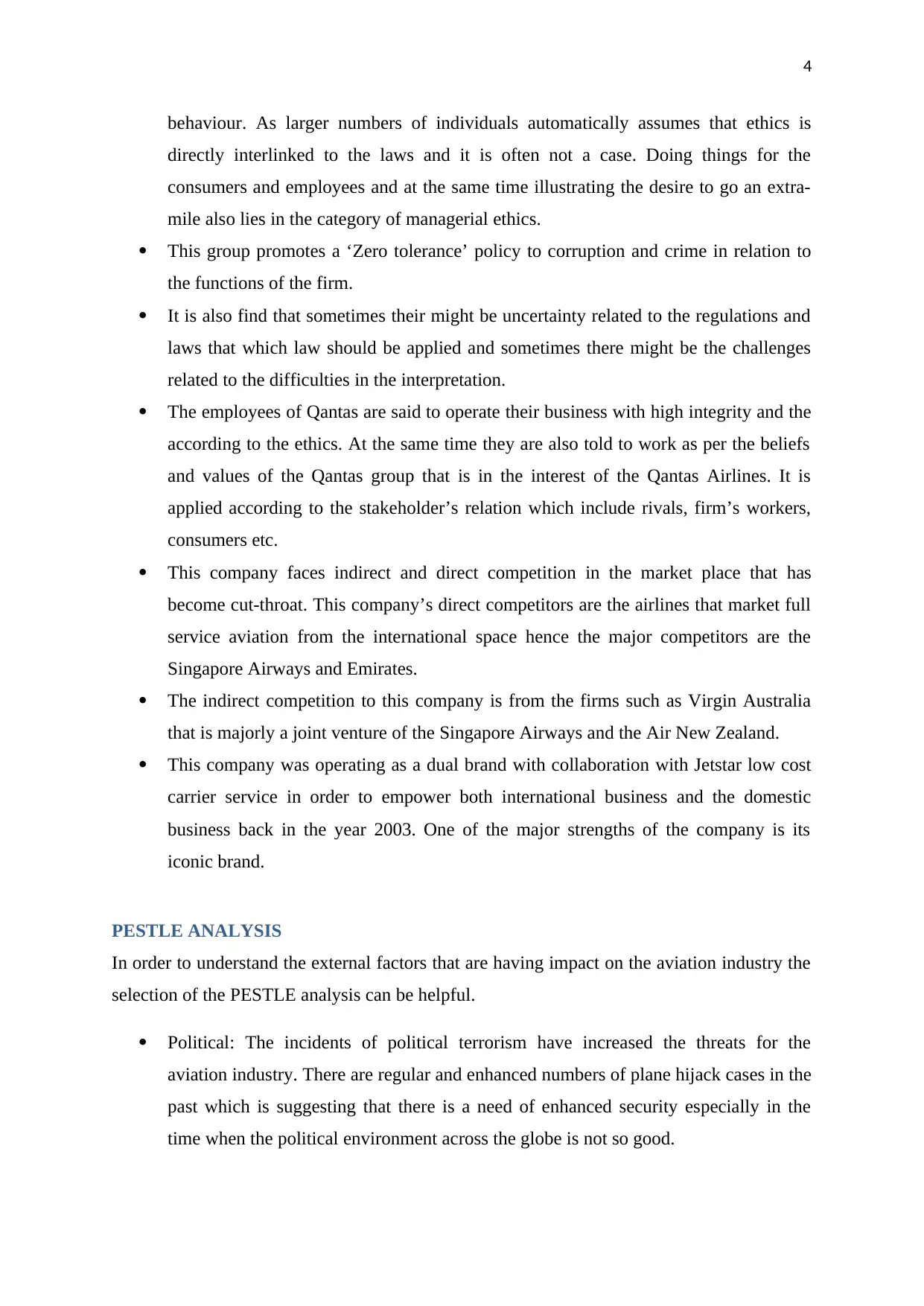
4
behaviour. As larger numbers of individuals automatically assumes that ethics is
directly interlinked to the laws and it is often not a case. Doing things for the
consumers and employees and at the same time illustrating the desire to go an extra-
mile also lies in the category of managerial ethics.
This group promotes a ‘Zero tolerance’ policy to corruption and crime in relation to
the functions of the firm.
It is also find that sometimes their might be uncertainty related to the regulations and
laws that which law should be applied and sometimes there might be the challenges
related to the difficulties in the interpretation.
The employees of Qantas are said to operate their business with high integrity and the
according to the ethics. At the same time they are also told to work as per the beliefs
and values of the Qantas group that is in the interest of the Qantas Airlines. It is
applied according to the stakeholder’s relation which include rivals, firm’s workers,
consumers etc.
This company faces indirect and direct competition in the market place that has
become cut-throat. This company’s direct competitors are the airlines that market full
service aviation from the international space hence the major competitors are the
Singapore Airways and Emirates.
The indirect competition to this company is from the firms such as Virgin Australia
that is majorly a joint venture of the Singapore Airways and the Air New Zealand.
This company was operating as a dual brand with collaboration with Jetstar low cost
carrier service in order to empower both international business and the domestic
business back in the year 2003. One of the major strengths of the company is its
iconic brand.
PESTLE ANALYSIS
In order to understand the external factors that are having impact on the aviation industry the
selection of the PESTLE analysis can be helpful.
Political: The incidents of political terrorism have increased the threats for the
aviation industry. There are regular and enhanced numbers of plane hijack cases in the
past which is suggesting that there is a need of enhanced security especially in the
time when the political environment across the globe is not so good.
behaviour. As larger numbers of individuals automatically assumes that ethics is
directly interlinked to the laws and it is often not a case. Doing things for the
consumers and employees and at the same time illustrating the desire to go an extra-
mile also lies in the category of managerial ethics.
This group promotes a ‘Zero tolerance’ policy to corruption and crime in relation to
the functions of the firm.
It is also find that sometimes their might be uncertainty related to the regulations and
laws that which law should be applied and sometimes there might be the challenges
related to the difficulties in the interpretation.
The employees of Qantas are said to operate their business with high integrity and the
according to the ethics. At the same time they are also told to work as per the beliefs
and values of the Qantas group that is in the interest of the Qantas Airlines. It is
applied according to the stakeholder’s relation which include rivals, firm’s workers,
consumers etc.
This company faces indirect and direct competition in the market place that has
become cut-throat. This company’s direct competitors are the airlines that market full
service aviation from the international space hence the major competitors are the
Singapore Airways and Emirates.
The indirect competition to this company is from the firms such as Virgin Australia
that is majorly a joint venture of the Singapore Airways and the Air New Zealand.
This company was operating as a dual brand with collaboration with Jetstar low cost
carrier service in order to empower both international business and the domestic
business back in the year 2003. One of the major strengths of the company is its
iconic brand.
PESTLE ANALYSIS
In order to understand the external factors that are having impact on the aviation industry the
selection of the PESTLE analysis can be helpful.
Political: The incidents of political terrorism have increased the threats for the
aviation industry. There are regular and enhanced numbers of plane hijack cases in the
past which is suggesting that there is a need of enhanced security especially in the
time when the political environment across the globe is not so good.
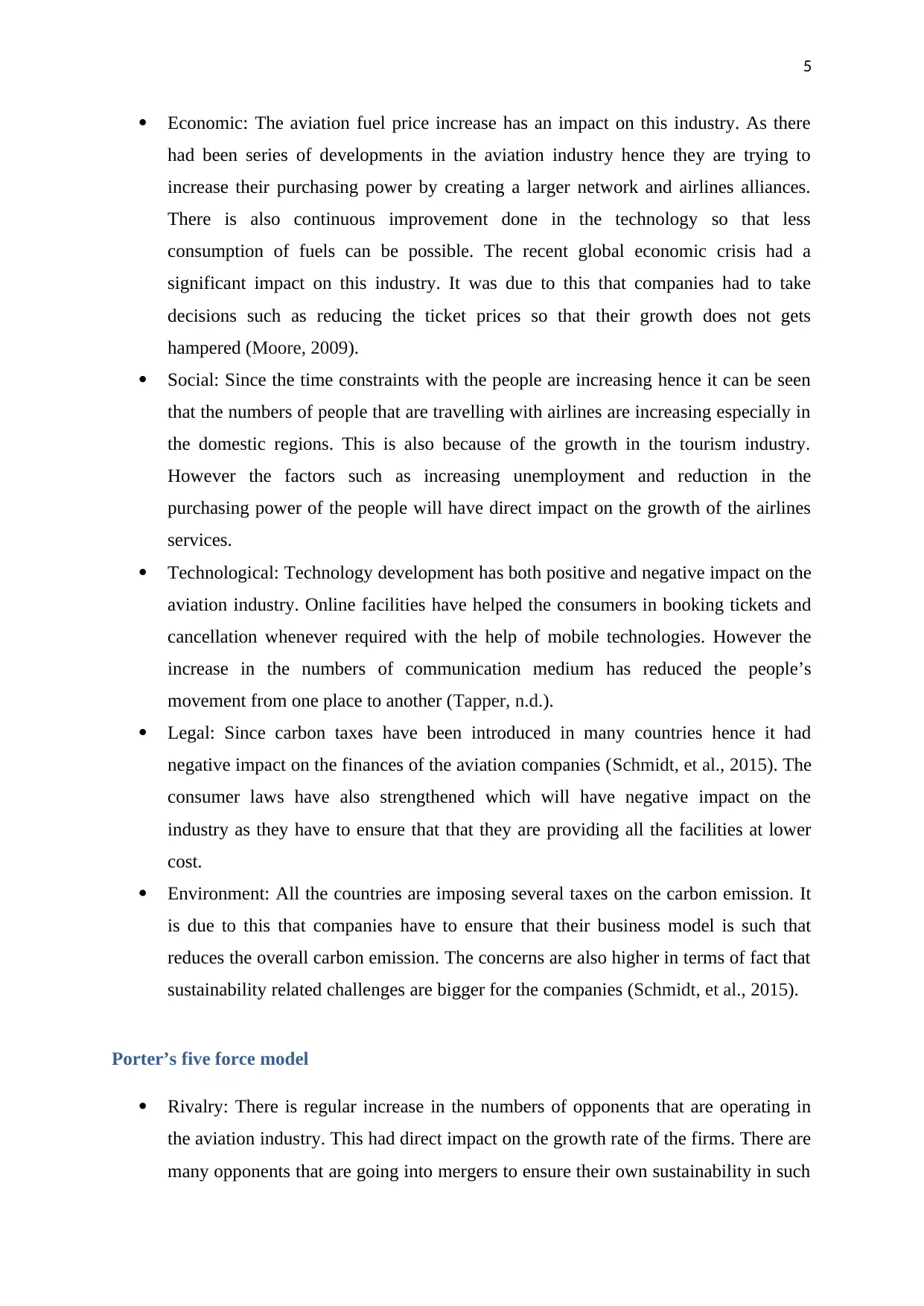
5
Economic: The aviation fuel price increase has an impact on this industry. As there
had been series of developments in the aviation industry hence they are trying to
increase their purchasing power by creating a larger network and airlines alliances.
There is also continuous improvement done in the technology so that less
consumption of fuels can be possible. The recent global economic crisis had a
significant impact on this industry. It was due to this that companies had to take
decisions such as reducing the ticket prices so that their growth does not gets
hampered (Moore, 2009).
Social: Since the time constraints with the people are increasing hence it can be seen
that the numbers of people that are travelling with airlines are increasing especially in
the domestic regions. This is also because of the growth in the tourism industry.
However the factors such as increasing unemployment and reduction in the
purchasing power of the people will have direct impact on the growth of the airlines
services.
Technological: Technology development has both positive and negative impact on the
aviation industry. Online facilities have helped the consumers in booking tickets and
cancellation whenever required with the help of mobile technologies. However the
increase in the numbers of communication medium has reduced the people’s
movement from one place to another (Tapper, n.d.).
Legal: Since carbon taxes have been introduced in many countries hence it had
negative impact on the finances of the aviation companies (Schmidt, et al., 2015). The
consumer laws have also strengthened which will have negative impact on the
industry as they have to ensure that that they are providing all the facilities at lower
cost.
Environment: All the countries are imposing several taxes on the carbon emission. It
is due to this that companies have to ensure that their business model is such that
reduces the overall carbon emission. The concerns are also higher in terms of fact that
sustainability related challenges are bigger for the companies (Schmidt, et al., 2015).
Porter’s five force model
Rivalry: There is regular increase in the numbers of opponents that are operating in
the aviation industry. This had direct impact on the growth rate of the firms. There are
many opponents that are going into mergers to ensure their own sustainability in such
Economic: The aviation fuel price increase has an impact on this industry. As there
had been series of developments in the aviation industry hence they are trying to
increase their purchasing power by creating a larger network and airlines alliances.
There is also continuous improvement done in the technology so that less
consumption of fuels can be possible. The recent global economic crisis had a
significant impact on this industry. It was due to this that companies had to take
decisions such as reducing the ticket prices so that their growth does not gets
hampered (Moore, 2009).
Social: Since the time constraints with the people are increasing hence it can be seen
that the numbers of people that are travelling with airlines are increasing especially in
the domestic regions. This is also because of the growth in the tourism industry.
However the factors such as increasing unemployment and reduction in the
purchasing power of the people will have direct impact on the growth of the airlines
services.
Technological: Technology development has both positive and negative impact on the
aviation industry. Online facilities have helped the consumers in booking tickets and
cancellation whenever required with the help of mobile technologies. However the
increase in the numbers of communication medium has reduced the people’s
movement from one place to another (Tapper, n.d.).
Legal: Since carbon taxes have been introduced in many countries hence it had
negative impact on the finances of the aviation companies (Schmidt, et al., 2015). The
consumer laws have also strengthened which will have negative impact on the
industry as they have to ensure that that they are providing all the facilities at lower
cost.
Environment: All the countries are imposing several taxes on the carbon emission. It
is due to this that companies have to ensure that their business model is such that
reduces the overall carbon emission. The concerns are also higher in terms of fact that
sustainability related challenges are bigger for the companies (Schmidt, et al., 2015).
Porter’s five force model
Rivalry: There is regular increase in the numbers of opponents that are operating in
the aviation industry. This had direct impact on the growth rate of the firms. There are
many opponents that are going into mergers to ensure their own sustainability in such
⊘ This is a preview!⊘
Do you want full access?
Subscribe today to unlock all pages.

Trusted by 1+ million students worldwide
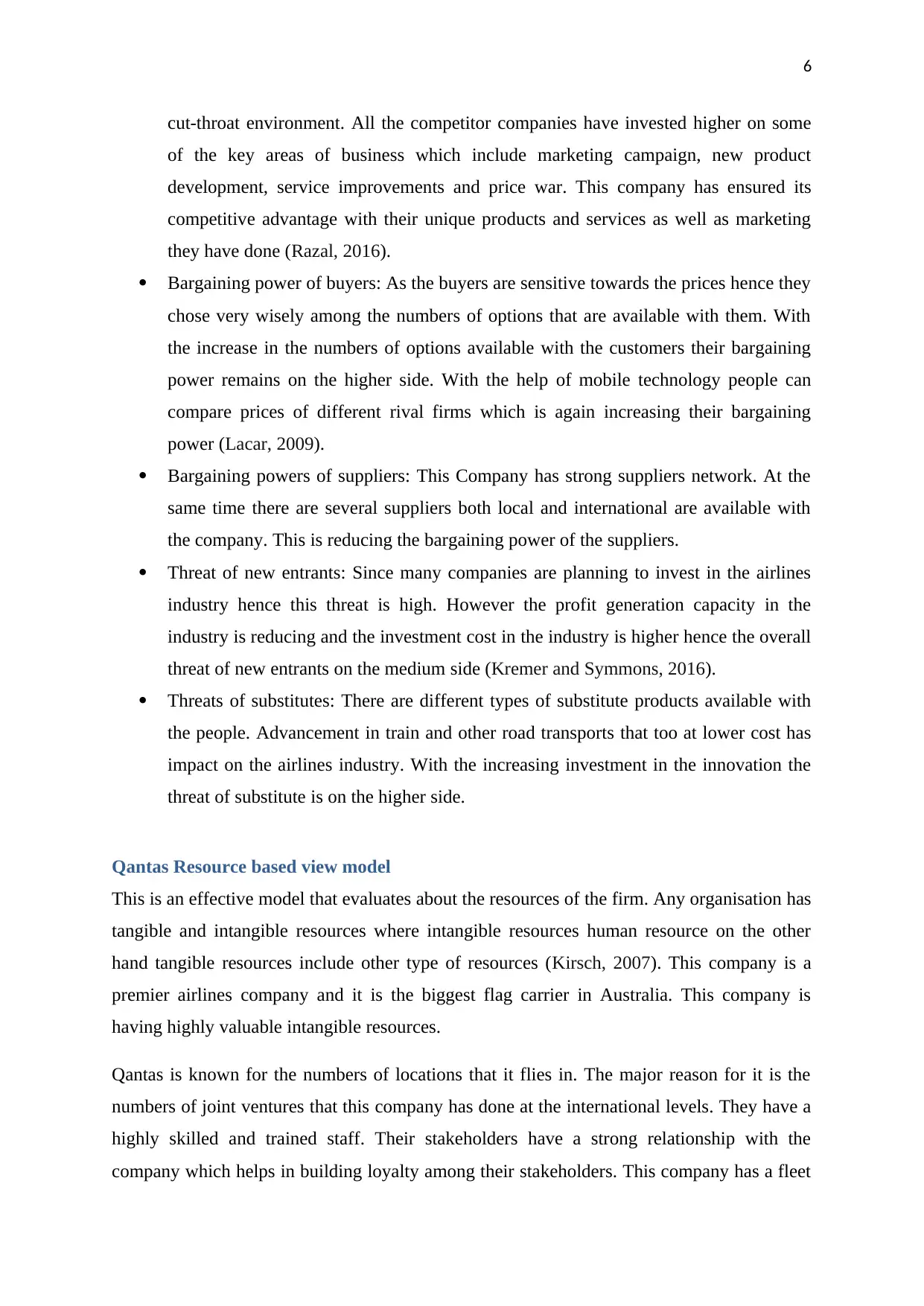
6
cut-throat environment. All the competitor companies have invested higher on some
of the key areas of business which include marketing campaign, new product
development, service improvements and price war. This company has ensured its
competitive advantage with their unique products and services as well as marketing
they have done (Razal, 2016).
Bargaining power of buyers: As the buyers are sensitive towards the prices hence they
chose very wisely among the numbers of options that are available with them. With
the increase in the numbers of options available with the customers their bargaining
power remains on the higher side. With the help of mobile technology people can
compare prices of different rival firms which is again increasing their bargaining
power (Lacar, 2009).
Bargaining powers of suppliers: This Company has strong suppliers network. At the
same time there are several suppliers both local and international are available with
the company. This is reducing the bargaining power of the suppliers.
Threat of new entrants: Since many companies are planning to invest in the airlines
industry hence this threat is high. However the profit generation capacity in the
industry is reducing and the investment cost in the industry is higher hence the overall
threat of new entrants on the medium side (Kremer and Symmons, 2016).
Threats of substitutes: There are different types of substitute products available with
the people. Advancement in train and other road transports that too at lower cost has
impact on the airlines industry. With the increasing investment in the innovation the
threat of substitute is on the higher side.
Qantas Resource based view model
This is an effective model that evaluates about the resources of the firm. Any organisation has
tangible and intangible resources where intangible resources human resource on the other
hand tangible resources include other type of resources (Kirsch, 2007). This company is a
premier airlines company and it is the biggest flag carrier in Australia. This company is
having highly valuable intangible resources.
Qantas is known for the numbers of locations that it flies in. The major reason for it is the
numbers of joint ventures that this company has done at the international levels. They have a
highly skilled and trained staff. Their stakeholders have a strong relationship with the
company which helps in building loyalty among their stakeholders. This company has a fleet
cut-throat environment. All the competitor companies have invested higher on some
of the key areas of business which include marketing campaign, new product
development, service improvements and price war. This company has ensured its
competitive advantage with their unique products and services as well as marketing
they have done (Razal, 2016).
Bargaining power of buyers: As the buyers are sensitive towards the prices hence they
chose very wisely among the numbers of options that are available with them. With
the increase in the numbers of options available with the customers their bargaining
power remains on the higher side. With the help of mobile technology people can
compare prices of different rival firms which is again increasing their bargaining
power (Lacar, 2009).
Bargaining powers of suppliers: This Company has strong suppliers network. At the
same time there are several suppliers both local and international are available with
the company. This is reducing the bargaining power of the suppliers.
Threat of new entrants: Since many companies are planning to invest in the airlines
industry hence this threat is high. However the profit generation capacity in the
industry is reducing and the investment cost in the industry is higher hence the overall
threat of new entrants on the medium side (Kremer and Symmons, 2016).
Threats of substitutes: There are different types of substitute products available with
the people. Advancement in train and other road transports that too at lower cost has
impact on the airlines industry. With the increasing investment in the innovation the
threat of substitute is on the higher side.
Qantas Resource based view model
This is an effective model that evaluates about the resources of the firm. Any organisation has
tangible and intangible resources where intangible resources human resource on the other
hand tangible resources include other type of resources (Kirsch, 2007). This company is a
premier airlines company and it is the biggest flag carrier in Australia. This company is
having highly valuable intangible resources.
Qantas is known for the numbers of locations that it flies in. The major reason for it is the
numbers of joint ventures that this company has done at the international levels. They have a
highly skilled and trained staff. Their stakeholders have a strong relationship with the
company which helps in building loyalty among their stakeholders. This company has a fleet
Paraphrase This Document
Need a fresh take? Get an instant paraphrase of this document with our AI Paraphraser
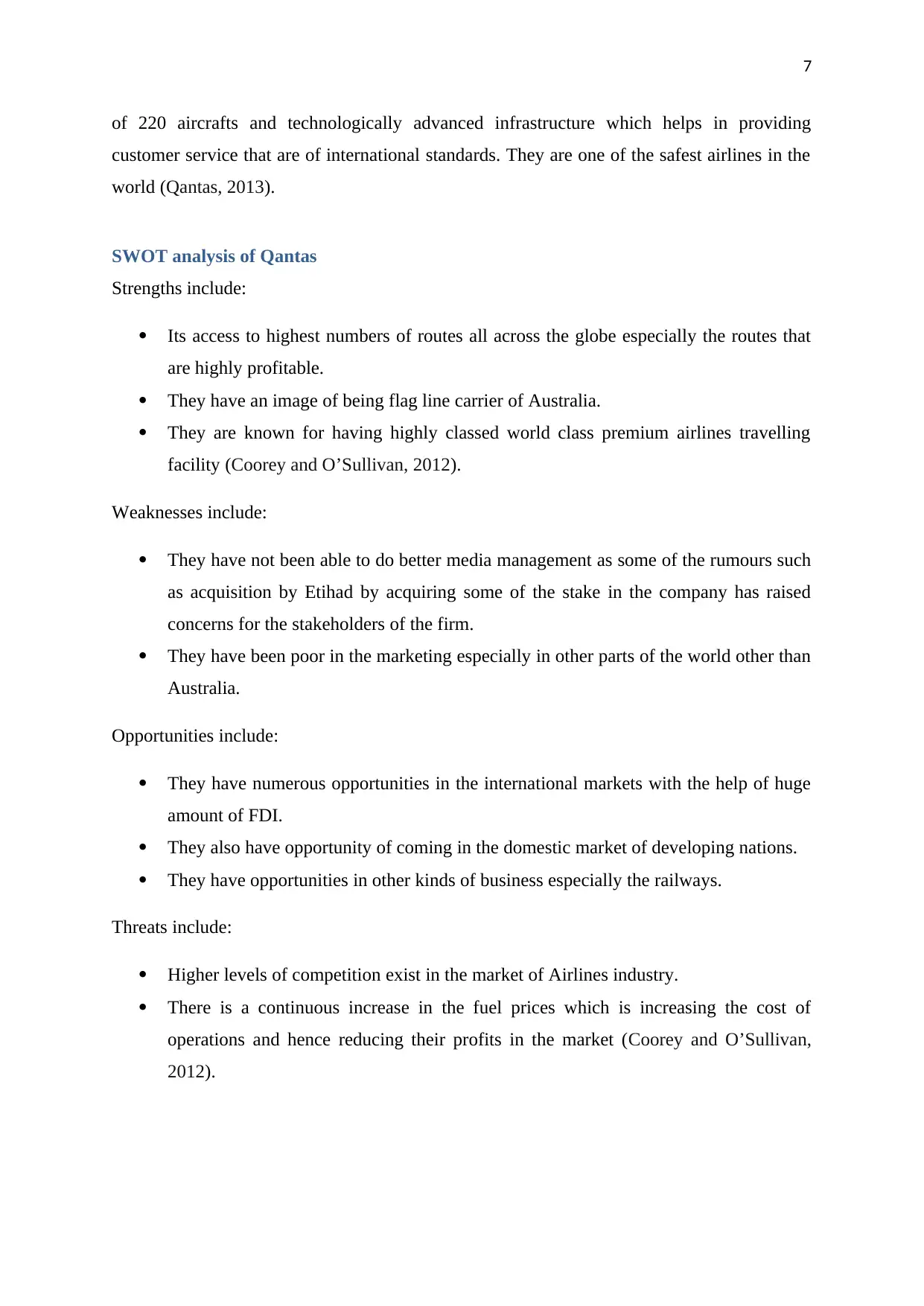
7
of 220 aircrafts and technologically advanced infrastructure which helps in providing
customer service that are of international standards. They are one of the safest airlines in the
world (Qantas, 2013).
SWOT analysis of Qantas
Strengths include:
Its access to highest numbers of routes all across the globe especially the routes that
are highly profitable.
They have an image of being flag line carrier of Australia.
They are known for having highly classed world class premium airlines travelling
facility (Coorey and O’Sullivan, 2012).
Weaknesses include:
They have not been able to do better media management as some of the rumours such
as acquisition by Etihad by acquiring some of the stake in the company has raised
concerns for the stakeholders of the firm.
They have been poor in the marketing especially in other parts of the world other than
Australia.
Opportunities include:
They have numerous opportunities in the international markets with the help of huge
amount of FDI.
They also have opportunity of coming in the domestic market of developing nations.
They have opportunities in other kinds of business especially the railways.
Threats include:
Higher levels of competition exist in the market of Airlines industry.
There is a continuous increase in the fuel prices which is increasing the cost of
operations and hence reducing their profits in the market (Coorey and O’Sullivan,
2012).
of 220 aircrafts and technologically advanced infrastructure which helps in providing
customer service that are of international standards. They are one of the safest airlines in the
world (Qantas, 2013).
SWOT analysis of Qantas
Strengths include:
Its access to highest numbers of routes all across the globe especially the routes that
are highly profitable.
They have an image of being flag line carrier of Australia.
They are known for having highly classed world class premium airlines travelling
facility (Coorey and O’Sullivan, 2012).
Weaknesses include:
They have not been able to do better media management as some of the rumours such
as acquisition by Etihad by acquiring some of the stake in the company has raised
concerns for the stakeholders of the firm.
They have been poor in the marketing especially in other parts of the world other than
Australia.
Opportunities include:
They have numerous opportunities in the international markets with the help of huge
amount of FDI.
They also have opportunity of coming in the domestic market of developing nations.
They have opportunities in other kinds of business especially the railways.
Threats include:
Higher levels of competition exist in the market of Airlines industry.
There is a continuous increase in the fuel prices which is increasing the cost of
operations and hence reducing their profits in the market (Coorey and O’Sullivan,
2012).
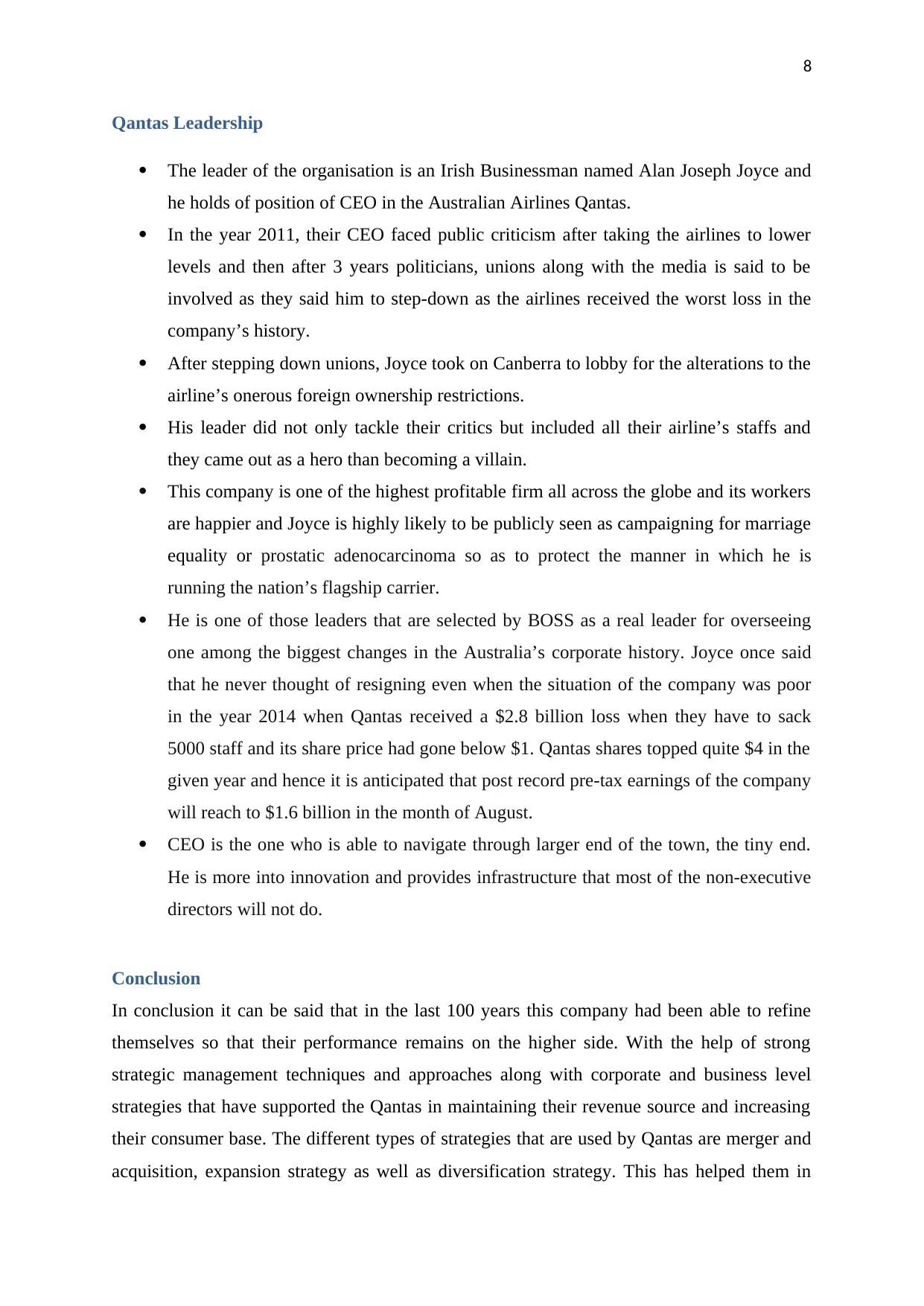
8
Qantas Leadership
The leader of the organisation is an Irish Businessman named Alan Joseph Joyce and
he holds of position of CEO in the Australian Airlines Qantas.
In the year 2011, their CEO faced public criticism after taking the airlines to lower
levels and then after 3 years politicians, unions along with the media is said to be
involved as they said him to step-down as the airlines received the worst loss in the
company’s history.
After stepping down unions, Joyce took on Canberra to lobby for the alterations to the
airline’s onerous foreign ownership restrictions.
His leader did not only tackle their critics but included all their airline’s staffs and
they came out as a hero than becoming a villain.
This company is one of the highest profitable firm all across the globe and its workers
are happier and Joyce is highly likely to be publicly seen as campaigning for marriage
equality or prostatic adenocarcinoma so as to protect the manner in which he is
running the nation’s flagship carrier.
He is one of those leaders that are selected by BOSS as a real leader for overseeing
one among the biggest changes in the Australia’s corporate history. Joyce once said
that he never thought of resigning even when the situation of the company was poor
in the year 2014 when Qantas received a $2.8 billion loss when they have to sack
5000 staff and its share price had gone below $1. Qantas shares topped quite $4 in the
given year and hence it is anticipated that post record pre-tax earnings of the company
will reach to $1.6 billion in the month of August.
CEO is the one who is able to navigate through larger end of the town, the tiny end.
He is more into innovation and provides infrastructure that most of the non-executive
directors will not do.
Conclusion
In conclusion it can be said that in the last 100 years this company had been able to refine
themselves so that their performance remains on the higher side. With the help of strong
strategic management techniques and approaches along with corporate and business level
strategies that have supported the Qantas in maintaining their revenue source and increasing
their consumer base. The different types of strategies that are used by Qantas are merger and
acquisition, expansion strategy as well as diversification strategy. This has helped them in
Qantas Leadership
The leader of the organisation is an Irish Businessman named Alan Joseph Joyce and
he holds of position of CEO in the Australian Airlines Qantas.
In the year 2011, their CEO faced public criticism after taking the airlines to lower
levels and then after 3 years politicians, unions along with the media is said to be
involved as they said him to step-down as the airlines received the worst loss in the
company’s history.
After stepping down unions, Joyce took on Canberra to lobby for the alterations to the
airline’s onerous foreign ownership restrictions.
His leader did not only tackle their critics but included all their airline’s staffs and
they came out as a hero than becoming a villain.
This company is one of the highest profitable firm all across the globe and its workers
are happier and Joyce is highly likely to be publicly seen as campaigning for marriage
equality or prostatic adenocarcinoma so as to protect the manner in which he is
running the nation’s flagship carrier.
He is one of those leaders that are selected by BOSS as a real leader for overseeing
one among the biggest changes in the Australia’s corporate history. Joyce once said
that he never thought of resigning even when the situation of the company was poor
in the year 2014 when Qantas received a $2.8 billion loss when they have to sack
5000 staff and its share price had gone below $1. Qantas shares topped quite $4 in the
given year and hence it is anticipated that post record pre-tax earnings of the company
will reach to $1.6 billion in the month of August.
CEO is the one who is able to navigate through larger end of the town, the tiny end.
He is more into innovation and provides infrastructure that most of the non-executive
directors will not do.
Conclusion
In conclusion it can be said that in the last 100 years this company had been able to refine
themselves so that their performance remains on the higher side. With the help of strong
strategic management techniques and approaches along with corporate and business level
strategies that have supported the Qantas in maintaining their revenue source and increasing
their consumer base. The different types of strategies that are used by Qantas are merger and
acquisition, expansion strategy as well as diversification strategy. This has helped them in
⊘ This is a preview!⊘
Do you want full access?
Subscribe today to unlock all pages.

Trusted by 1+ million students worldwide
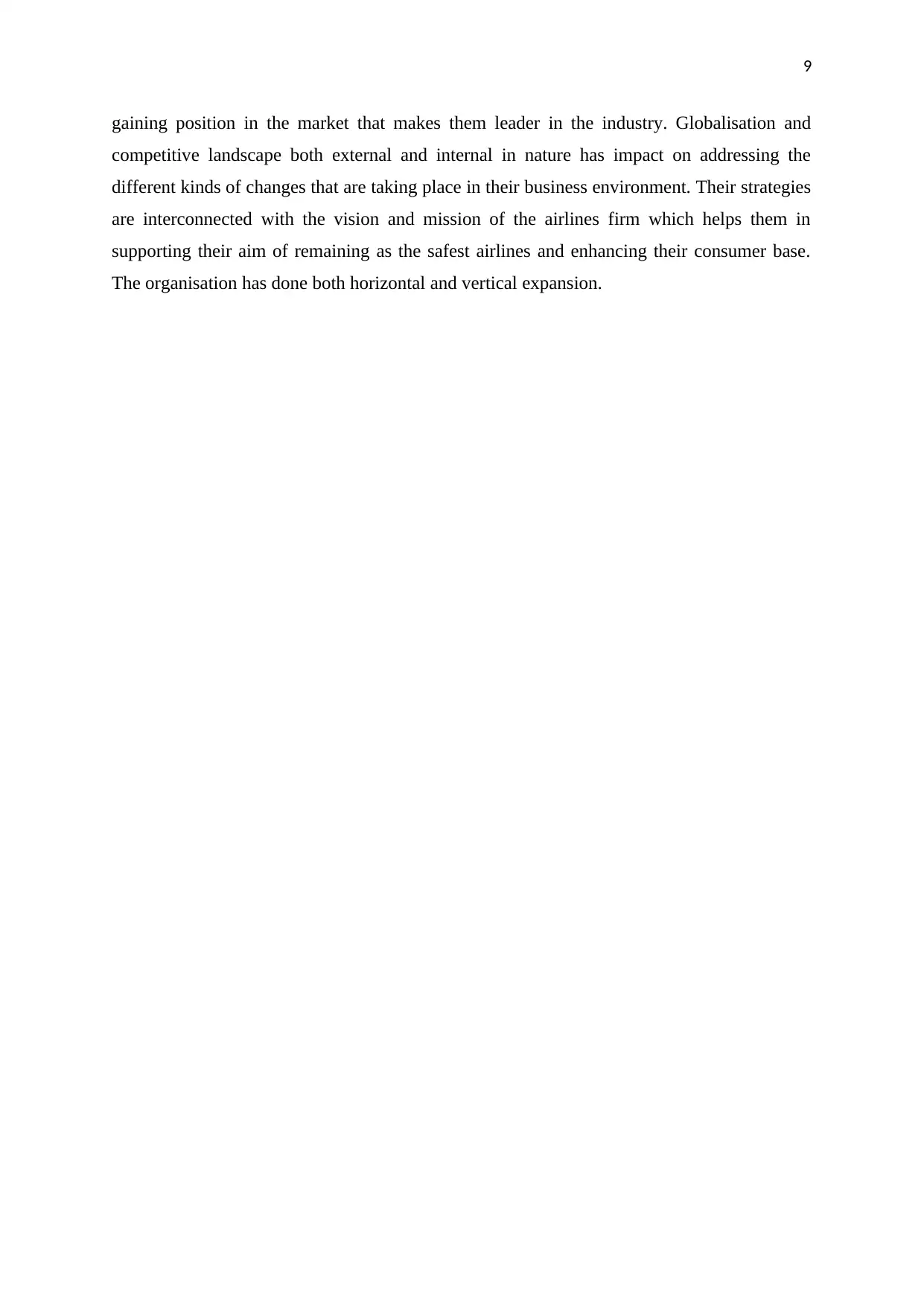
9
gaining position in the market that makes them leader in the industry. Globalisation and
competitive landscape both external and internal in nature has impact on addressing the
different kinds of changes that are taking place in their business environment. Their strategies
are interconnected with the vision and mission of the airlines firm which helps them in
supporting their aim of remaining as the safest airlines and enhancing their consumer base.
The organisation has done both horizontal and vertical expansion.
gaining position in the market that makes them leader in the industry. Globalisation and
competitive landscape both external and internal in nature has impact on addressing the
different kinds of changes that are taking place in their business environment. Their strategies
are interconnected with the vision and mission of the airlines firm which helps them in
supporting their aim of remaining as the safest airlines and enhancing their consumer base.
The organisation has done both horizontal and vertical expansion.
Paraphrase This Document
Need a fresh take? Get an instant paraphrase of this document with our AI Paraphraser
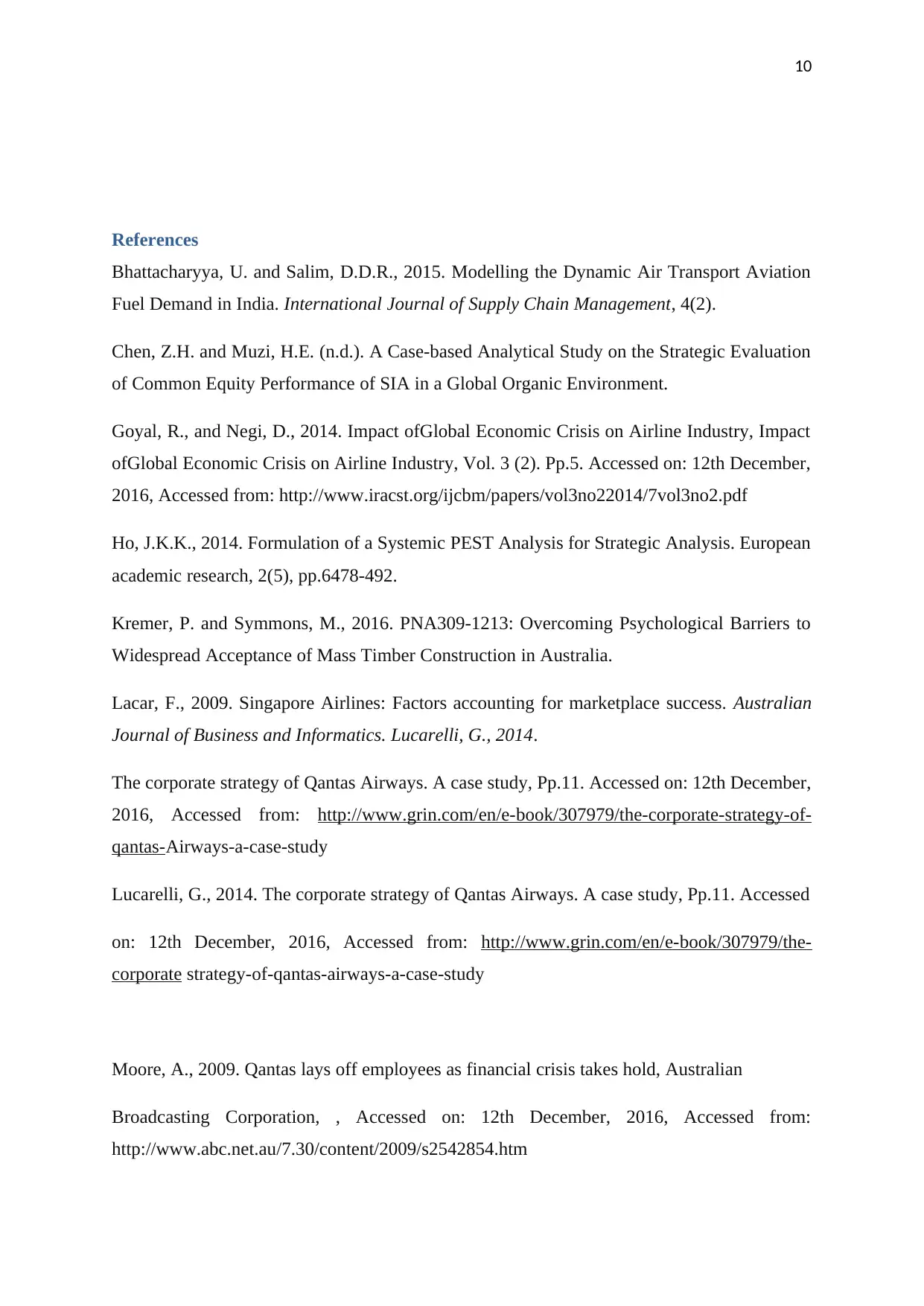
10
References
Bhattacharyya, U. and Salim, D.D.R., 2015. Modelling the Dynamic Air Transport Aviation
Fuel Demand in India. International Journal of Supply Chain Management, 4(2).
Chen, Z.H. and Muzi, H.E. (n.d.). A Case-based Analytical Study on the Strategic Evaluation
of Common Equity Performance of SIA in a Global Organic Environment.
Goyal, R., and Negi, D., 2014. Impact ofGlobal Economic Crisis on Airline Industry, Impact
ofGlobal Economic Crisis on Airline Industry, Vol. 3 (2). Pp.5. Accessed on: 12th December,
2016, Accessed from: http://www.iracst.org/ijcbm/papers/vol3no22014/7vol3no2.pdf
Ho, J.K.K., 2014. Formulation of a Systemic PEST Analysis for Strategic Analysis. European
academic research, 2(5), pp.6478-492.
Kremer, P. and Symmons, M., 2016. PNA309-1213: Overcoming Psychological Barriers to
Widespread Acceptance of Mass Timber Construction in Australia.
Lacar, F., 2009. Singapore Airlines: Factors accounting for marketplace success. Australian
Journal of Business and Informatics. Lucarelli, G., 2014.
The corporate strategy of Qantas Airways. A case study, Pp.11. Accessed on: 12th December,
2016, Accessed from: http://www.grin.com/en/e-book/307979/the-corporate-strategy-of-
qantas-Airways-a-case-study
Lucarelli, G., 2014. The corporate strategy of Qantas Airways. A case study, Pp.11. Accessed
on: 12th December, 2016, Accessed from: http://www.grin.com/en/e-book/307979/the-
corporate strategy-of-qantas-airways-a-case-study
Moore, A., 2009. Qantas lays off employees as financial crisis takes hold, Australian
Broadcasting Corporation, , Accessed on: 12th December, 2016, Accessed from:
http://www.abc.net.au/7.30/content/2009/s2542854.htm
References
Bhattacharyya, U. and Salim, D.D.R., 2015. Modelling the Dynamic Air Transport Aviation
Fuel Demand in India. International Journal of Supply Chain Management, 4(2).
Chen, Z.H. and Muzi, H.E. (n.d.). A Case-based Analytical Study on the Strategic Evaluation
of Common Equity Performance of SIA in a Global Organic Environment.
Goyal, R., and Negi, D., 2014. Impact ofGlobal Economic Crisis on Airline Industry, Impact
ofGlobal Economic Crisis on Airline Industry, Vol. 3 (2). Pp.5. Accessed on: 12th December,
2016, Accessed from: http://www.iracst.org/ijcbm/papers/vol3no22014/7vol3no2.pdf
Ho, J.K.K., 2014. Formulation of a Systemic PEST Analysis for Strategic Analysis. European
academic research, 2(5), pp.6478-492.
Kremer, P. and Symmons, M., 2016. PNA309-1213: Overcoming Psychological Barriers to
Widespread Acceptance of Mass Timber Construction in Australia.
Lacar, F., 2009. Singapore Airlines: Factors accounting for marketplace success. Australian
Journal of Business and Informatics. Lucarelli, G., 2014.
The corporate strategy of Qantas Airways. A case study, Pp.11. Accessed on: 12th December,
2016, Accessed from: http://www.grin.com/en/e-book/307979/the-corporate-strategy-of-
qantas-Airways-a-case-study
Lucarelli, G., 2014. The corporate strategy of Qantas Airways. A case study, Pp.11. Accessed
on: 12th December, 2016, Accessed from: http://www.grin.com/en/e-book/307979/the-
corporate strategy-of-qantas-airways-a-case-study
Moore, A., 2009. Qantas lays off employees as financial crisis takes hold, Australian
Broadcasting Corporation, , Accessed on: 12th December, 2016, Accessed from:
http://www.abc.net.au/7.30/content/2009/s2542854.htm
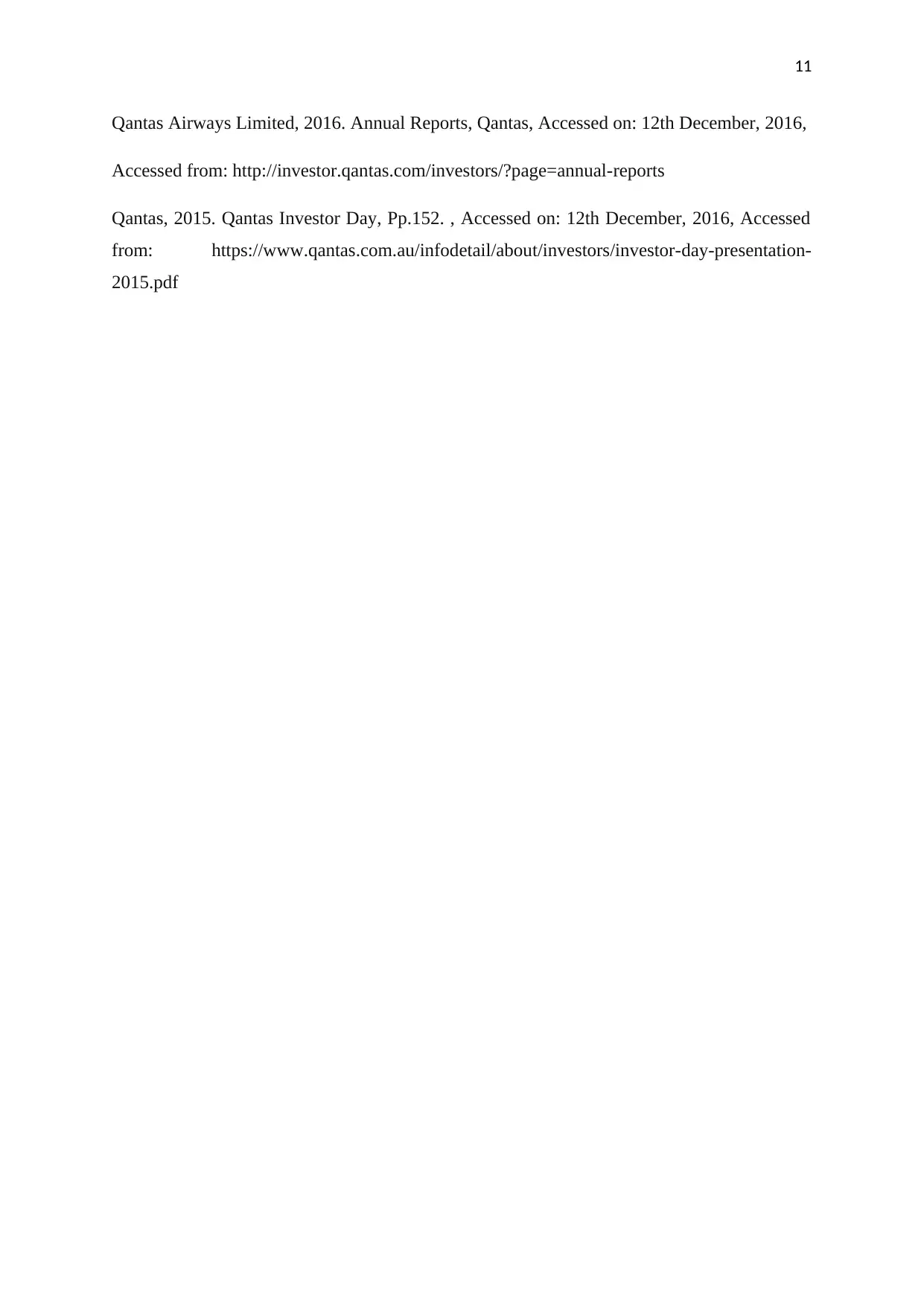
11
Qantas Airways Limited, 2016. Annual Reports, Qantas, Accessed on: 12th December, 2016,
Accessed from: http://investor.qantas.com/investors/?page=annual-reports
Qantas, 2015. Qantas Investor Day, Pp.152. , Accessed on: 12th December, 2016, Accessed
from: https://www.qantas.com.au/infodetail/about/investors/investor-day-presentation-
2015.pdf
Qantas Airways Limited, 2016. Annual Reports, Qantas, Accessed on: 12th December, 2016,
Accessed from: http://investor.qantas.com/investors/?page=annual-reports
Qantas, 2015. Qantas Investor Day, Pp.152. , Accessed on: 12th December, 2016, Accessed
from: https://www.qantas.com.au/infodetail/about/investors/investor-day-presentation-
2015.pdf
⊘ This is a preview!⊘
Do you want full access?
Subscribe today to unlock all pages.

Trusted by 1+ million students worldwide
1 out of 12
Related Documents
Your All-in-One AI-Powered Toolkit for Academic Success.
+13062052269
info@desklib.com
Available 24*7 on WhatsApp / Email
![[object Object]](/_next/static/media/star-bottom.7253800d.svg)
Unlock your academic potential
Copyright © 2020–2025 A2Z Services. All Rights Reserved. Developed and managed by ZUCOL.





